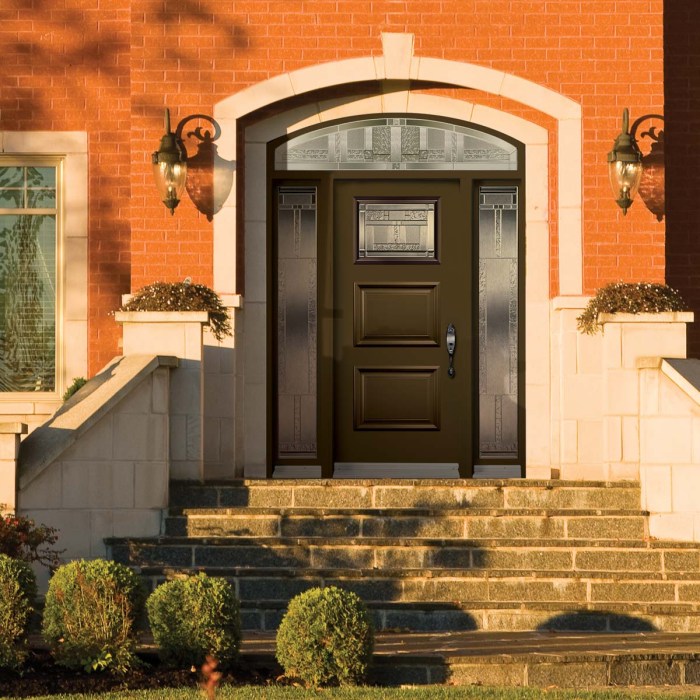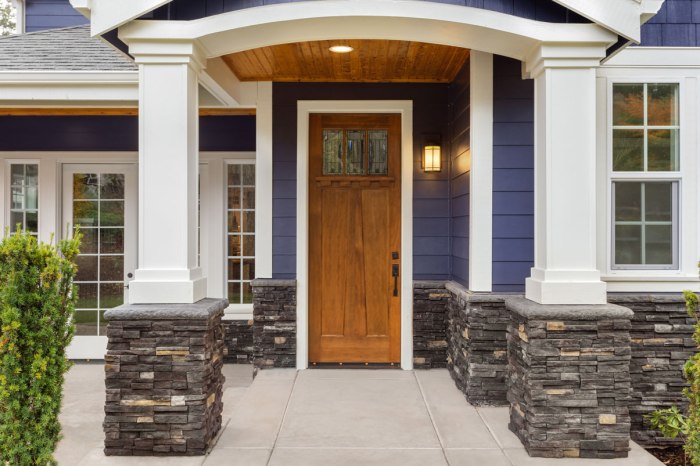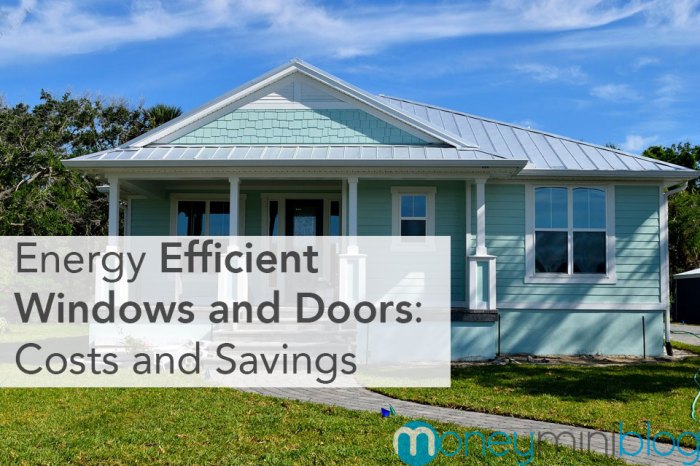Energy-Efficient Exterior Doors: Costs and Savings
Energy-Efficient Exterior Doors: Costs and Savings sets the stage for this enthralling narrative, offering readers a glimpse into a story that is rich in detail and brimming with originality from the outset. Stepping into a world of energy efficiency, we’ll explore how exterior doors can significantly impact your home’s energy consumption and your wallet.
From understanding the various types of energy-efficient doors to delving into their key features and cost considerations, we’ll uncover the secrets to creating a more sustainable and cost-effective home.
This comprehensive guide will empower you with the knowledge to make informed decisions about your exterior doors, ensuring you reap the benefits of reduced energy bills and a smaller environmental footprint. We’ll examine the latest technologies, explore the financial advantages, and provide practical advice on installation and maintenance.
Join us as we unlock the potential of energy-efficient exterior doors and embark on a journey toward a brighter, more sustainable future.
Energy-Efficient Exterior Doors: Costs and Savings
In today’s world, where energy conservation is paramount, choosing energy-efficient exterior doors can significantly reduce your energy consumption and save you money on heating and cooling costs. These doors act as a barrier against heat loss in winter and heat gain in summer, effectively improving the overall energy performance of your home.
Several factors contribute to the energy efficiency of exterior doors. These include the materials used, the design features, and the installation process. Understanding these factors can help you make informed decisions when selecting an energy-efficient door for your home.
Factors Influencing Energy Efficiency
The energy efficiency of an exterior door is determined by its ability to resist heat transfer. This resistance is measured by the U-value, which represents the rate of heat transfer through the door. A lower U-value indicates better insulation and higher energy efficiency.
- Materials:The materials used in the construction of the door play a significant role in its energy efficiency. Solid core doors, made from wood or foam-filled materials, offer better insulation than hollow core doors. Fiberglass and composite doors are also known for their excellent thermal performance.
- Glazing:If your door has windows, the type of glazing used can significantly impact its energy efficiency. Double- or triple-paned windows with low-E coatings and argon gas fill offer superior insulation compared to single-paned windows.
- Weatherstripping:Weatherstripping is essential for sealing gaps around the door frame, preventing drafts and heat loss. High-quality weatherstripping, such as foam or rubber seals, effectively minimizes air leakage.
- Door Frame:The door frame should be properly installed and insulated to prevent heat transfer. Using a high-quality door frame material, such as fiberglass or composite, and ensuring proper insulation can significantly improve energy efficiency.
Types of Energy-Efficient Exterior Doors
Choosing the right type of energy-efficient exterior door can significantly impact your home’s energy savings and overall comfort. Several types of doors offer excellent thermal performance and aesthetic appeal. This section explores the different types of energy-efficient exterior doors, comparing and contrasting their advantages and disadvantages.
Solid Core Doors
Solid core doors are known for their exceptional soundproofing and security. They consist of a solid core of wood, foam, or composite material, covered with a veneer or paint. The dense core provides excellent insulation, reducing heat transfer and noise transmission.
Advantages
- Superior Soundproofing:The solid core effectively absorbs sound waves, making them ideal for reducing noise from outside or between rooms.
- Enhanced Security:The solid core makes it more difficult to break through, offering greater protection against intruders.
- Good Insulation:The dense core provides excellent insulation, reducing heat transfer and helping to maintain a comfortable indoor temperature.
Disadvantages
- Heavy Weight:Solid core doors are heavier than other types, requiring stronger door frames and hinges.
- Higher Cost:They are typically more expensive than other types due to their construction and materials.
- Susceptibility to Moisture:Some solid core doors can be susceptible to moisture damage, requiring careful maintenance.
Fiberglass Doors
Fiberglass doors are gaining popularity due to their durability, low maintenance, and energy efficiency. They are made from fiberglass, a strong and resilient material that resists dents, scratches, and moisture.
Advantages
- High Durability:Fiberglass is highly resistant to dents, scratches, and fading, making it a long-lasting choice.
- Low Maintenance:Fiberglass requires minimal maintenance, as it resists moisture, rot, and insect infestation.
- Excellent Insulation:Fiberglass is an excellent insulator, reducing heat transfer and improving energy efficiency.
- Variety of Styles:Fiberglass doors are available in a wide range of styles and finishes to match any home’s design.
Disadvantages
Composite Doors
Composite doors combine different materials, such as wood, fiberglass, and polyurethane foam, to create a door that offers a balance of performance and affordability.
Advantages
- Improved Energy Efficiency:The combination of materials provides excellent insulation, reducing heat transfer and improving energy efficiency.
- Durable and Low Maintenance:Composite doors are resistant to moisture, rot, and insect infestation, requiring minimal maintenance.
- Variety of Styles:Composite doors are available in a wide range of styles and finishes to match different architectural preferences.
- Cost-Effective:Composite doors offer a good balance of performance and affordability, making them a popular choice for homeowners.
Disadvantages
- Potential for Cracking:Some composite doors can be susceptible to cracking, especially in extreme temperatures.
- Limited Customization:Composite doors may have fewer customization options compared to solid wood doors.
Key Features of Energy-Efficient Doors

Energy-efficient exterior doors are designed to minimize heat loss and air infiltration, leading to lower energy bills and a more comfortable living environment. They achieve this through a combination of key features that work together to create a barrier against the elements.
Insulation
Insulation plays a crucial role in preventing heat transfer through the door. It acts as a thermal barrier, slowing down the movement of heat from the warmer side to the colder side. The higher the R-value of the insulation, the better it is at resisting heat flow.
The R-value measures a material’s resistance to heat flow. A higher R-value indicates greater resistance and better insulation.
Energy-efficient doors typically use a core of polyurethane foam, fiberglass, or polystyrene insulation. These materials are injected or foamed into the door’s core, creating a dense, insulating layer.
Weatherstripping
Weatherstripping seals the gaps around the door frame, preventing drafts and air infiltration. It is essential for maintaining a comfortable indoor temperature and reducing energy loss.
- Door sweepsare installed at the bottom of the door to prevent air from entering underneath.
- Gasketingis placed around the door frame to seal the gaps between the door and the frame.
- Thresholdsare often used to create a barrier at the bottom of the door, further reducing air infiltration.
Weatherstripping is typically made of materials like rubber, vinyl, or foam, which are durable and resistant to wear and tear.
Glazing
Glazing refers to the glass panels used in the door. Energy-efficient doors often feature double- or triple-pane glazing, which helps to reduce heat loss and improve insulation.
- Low-E coatingsare applied to the glass to reflect infrared radiation, which is responsible for a significant portion of heat transfer.
- Argon gasis often filled between the panes to create an insulating barrier, further reducing heat transfer.
By reducing heat loss through the glass, energy-efficient doors can contribute to a more comfortable and energy-efficient home.
Cost Considerations

Investing in energy-efficient exterior doors can significantly impact your home’s energy efficiency and comfort, but it’s essential to understand the associated costs and potential savings. This section will delve into the typical cost range for energy-efficient exterior doors, taking into account material, size, and installation, and analyze the potential cost savings associated with installing these doors.
Cost Range for Energy-Efficient Exterior Doors
The cost of energy-efficient exterior doors can vary significantly depending on several factors, including the material, size, style, and features. Here’s a breakdown of typical cost ranges:
- Material:
- Fiberglass:$500 to $1,500 per door
- Wood:$800 to $3,000 per door
- Steel:$400 to $1,000 per door
- Composite:$600 to $2,000 per door
- Size:Larger doors generally cost more due to the increased material and labor required for installation.
- Style:Elaborate designs, such as double French doors or doors with intricate glass panels, can increase costs.
- Features:Additional features, such as sidelights, transoms, or built-in blinds, can also impact the overall cost.
- Installation:Professional installation costs typically range from $200 to $500 per door.
Potential Cost Savings
Installing energy-efficient exterior doors can lead to significant cost savings over time by reducing your heating and cooling costs. These savings stem from the improved insulation and air sealing properties of these doors.
- Reduced Heating and Cooling Costs:Energy-efficient doors can help prevent heat loss in the winter and heat gain in the summer, reducing the strain on your HVAC system. This can result in lower energy bills and potential savings of up to 15% on heating and cooling costs.
- Increased Home Value:Energy-efficient features, such as high-performance doors, are becoming increasingly desirable to homebuyers. Installing these doors can enhance your home’s value and make it more appealing to potential buyers.
“Energy-efficient doors can be a smart investment, providing both immediate and long-term benefits. The initial cost may seem high, but the potential savings on energy bills and increased home value can make them a worthwhile investment.”
Installation and Maintenance
Proper installation and regular maintenance are crucial for maximizing the energy efficiency and longevity of your energy-efficient exterior doors. By following these guidelines, you can ensure your doors perform optimally and provide long-lasting benefits.
Installation Guidelines
Proper installation is essential to ensure your energy-efficient doors function correctly and deliver the expected energy savings. Here are some key guidelines to follow:
- Professional Installation:Hiring a qualified and experienced contractor is highly recommended. They possess the expertise and tools to ensure accurate measurements, proper framing, and precise installation, maximizing the door’s performance and minimizing potential issues.
- Accurate Measurements:Precise measurements are crucial. Any errors can lead to gaps or misalignment, compromising the door’s seal and energy efficiency.
- Proper Framing:The door frame must be sturdy and properly constructed to support the door and prevent warping or sagging.
- Weatherstripping and Seals:Ensure the weatherstripping and seals are installed correctly and completely around the door frame. These elements play a critical role in preventing drafts and air leaks.
- Door Alignment and Operation:The door should be properly aligned and operate smoothly. A misaligned door can create gaps and hinder its ability to seal properly.
- Insulation:Ensure the door is properly insulated to prevent heat transfer. Check for gaps or areas where insulation is missing.
Maintenance Practices
Regular maintenance is essential to preserve the energy efficiency and longevity of your energy-efficient doors. Here are some essential practices to follow:
- Clean Regularly:Dust, dirt, and debris can accumulate on the door’s surface and around the seals, compromising their effectiveness. Clean the door and its components regularly to maintain their optimal performance.
- Inspect Weatherstripping and Seals:Regularly inspect the weatherstripping and seals for signs of wear, damage, or deterioration. Replace them as needed to maintain a tight seal and prevent drafts.
- Lubricate Hinges and Hardware:Lubricate the door hinges and other hardware periodically to ensure smooth operation and prevent squeaking or sticking.
- Check for Gaps or Leaks:Regularly inspect the door frame and surrounding areas for any gaps or leaks. Seal any gaps or leaks to maintain the door’s energy efficiency.
- Avoid Excessive Force:Avoid slamming the door or applying excessive force when opening or closing it. This can damage the door, hinges, or weatherstripping.
Government Incentives and Rebates
Installing energy-efficient exterior doors can significantly reduce your energy bills and contribute to a more sustainable lifestyle. However, the initial investment can be substantial. Fortunately, many government programs offer incentives and rebates to encourage homeowners to adopt energy-efficient practices, including door upgrades.These incentives are designed to offset the cost of upgrading to energy-efficient doors, making them more accessible to a wider range of homeowners.
Government Incentives and Rebates for Energy-Efficient Doors
The availability and specifics of these programs vary by location and may change over time. Therefore, it is crucial to contact your local utility company, state energy office, or federal agencies to determine what programs are available in your area and what eligibility requirements you must meet.Here is a general overview of the types of incentives and rebates you might find:
| Incentive Type | Eligibility Criteria | Application Process |
|---|---|---|
| Tax Credits | These are federal tax credits offered for specific energy-efficient upgrades, including doors. Eligibility requirements typically involve meeting certain energy efficiency standards and having the installation performed by a qualified contractor. | You claim the tax credit on your federal income tax return. Documentation from the contractor and product specifications may be required. |
| Rebates | Rebates are offered by utility companies or state energy offices. They are usually based on the energy savings potential of the door, and the amount of the rebate may vary depending on the door’s energy efficiency rating and the program’s specific criteria. | You typically apply for the rebate after the installation is complete. You may need to provide proof of purchase, installation, and energy efficiency ratings. |
| Loan Programs | These programs provide financing options for energy-efficient home improvements, including door upgrades. The terms and interest rates may vary depending on the program and your creditworthiness. | You apply for the loan through a participating lender or financial institution. You may need to provide information about your home, income, and credit history. |
Environmental Impact
Choosing energy-efficient exterior doors contributes significantly to environmental sustainability by reducing energy consumption and greenhouse gas emissions. These doors play a vital role in minimizing our impact on the planet, promoting a greener and more sustainable future.
Reduced Energy Consumption and Carbon Emissions
Energy-efficient doors, with their superior insulation and weather-tight seals, effectively prevent heat loss in the winter and heat gain in the summer. This translates to a lower reliance on heating and cooling systems, resulting in reduced energy consumption. By lowering energy consumption, we contribute to a reduction in greenhouse gas emissions, particularly carbon dioxide, which is a major contributor to climate change.
Energy-efficient doors can reduce your home’s energy consumption by up to 20%, significantly lowering your carbon footprint.
Positive Impact on Sustainability Efforts, Energy-Efficient Exterior Doors: Costs and Savings
The environmental benefits of energy-efficient doors extend beyond reduced energy consumption. These doors promote sustainability in various ways:
- Reduced reliance on fossil fuels:By decreasing energy consumption, energy-efficient doors reduce the need for fossil fuels, such as coal and natural gas, which are major sources of air pollution and climate change.
- Conservation of natural resources:By minimizing energy consumption, we conserve valuable natural resources like oil, gas, and water, which are used in the production and distribution of energy.
- Reduced waste:Energy-efficient doors are often made from recycled materials, reducing the amount of waste going to landfills.
Epilogue

In conclusion, embracing energy-efficient exterior doors is a wise investment that offers a multitude of benefits. By reducing energy consumption and saving money on heating and cooling costs, these doors contribute to a more sustainable lifestyle. The environmental impact of choosing energy-efficient options cannot be understated, as it helps to reduce carbon emissions and lessen our collective footprint on the planet.
With government incentives and rebates available, there has never been a better time to make the switch to energy-efficient exterior doors. So, step into a world of savings and sustainability – your home, your wallet, and the environment will thank you.
FAQ Corner: Energy-Efficient Exterior Doors: Costs And Savings
What are the most energy-efficient door materials?
Solid core, fiberglass, and composite doors are known for their excellent energy efficiency. Solid core doors offer superior insulation, while fiberglass and composite doors provide a balance of durability and aesthetics.
How much can I save on energy costs with energy-efficient doors?
The potential energy savings vary depending on factors like climate, existing insulation, and door usage. However, you can expect to see a noticeable reduction in your heating and cooling bills.
Do energy-efficient doors require special maintenance?
While energy-efficient doors generally require minimal maintenance, it’s essential to follow the manufacturer’s recommendations for cleaning and lubrication to ensure optimal performance and longevity.
Are there any government incentives for installing energy-efficient doors?
Yes, many governments offer rebates and tax credits for homeowners who install energy-efficient exterior doors. Check with your local energy provider or government website for details.